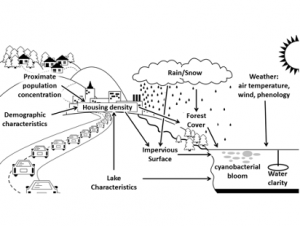Over the years, most of Kathy’s projects have tackled ecological research questions, often in freshwater ecosystems. For a sampling of past papers, click here for a Google Scholar search for papers Kathy has co-authored.
Our current ecological projects include:
- The “EPSCoR Project” (#RobotsDronesBloomsOhMy) – using unmanned autonomous vehicles that travel in the air, on the water surface, and underwater to develop “big data” that may be able to predict cyanobacterial bloom formation when analyzed using machine learning approaches. Led by Dartmouth research assistant professor Alberto Quattrini Li, a large team of researchers is trying to unravel the drivers of where, when, and ho
 w cyanobacterial blooms develop and spread by combining robotics and big data technologies with traditional limnological sampling.
w cyanobacterial blooms develop and spread by combining robotics and big data technologies with traditional limnological sampling.
- The “NASA Project” – using satellites and unmanned autonomous vehicles to understand eutrophication in northern New England lakes. Led by Dartmouth research assistant professor David Lutz, we are using the historical satellite archive and three decades of researcher- and citizen science observations to reconstruct past changes in water quality (Secchi dept
 h, chlorophyll a) in lakes across Maine, New Hampshire, Vermont, and New York. Our original goal was to hindcast water quality across the region, then look for associations with potential drivers of temporal change, including weather, human population characteristics, land use, and lake-specific variables. However, results to date suggest that hindcasting water quality in very clear lakes from remotely sensed data may not be possible – so we are also directly analyzing the associations between measured water quality and environmental drivers.
h, chlorophyll a) in lakes across Maine, New Hampshire, Vermont, and New York. Our original goal was to hindcast water quality across the region, then look for associations with potential drivers of temporal change, including weather, human population characteristics, land use, and lake-specific variables. However, results to date suggest that hindcasting water quality in very clear lakes from remotely sensed data may not be possible – so we are also directly analyzing the associations between measured water quality and environmental drivers.
- The “Gloeo” Project: Gloeotrichia echinulata, the beautiful colonial cyanobacterium shown below, is increasingly reported from low-nutrient lakes across Northern New England and adjoining regions in Canada. In collaboration with Cayelan Carey at Virginia Tech, Kathie Weathers at the Cary Institute, Holly Ewing and Meredith Greer at Bates College, and Denise Bruesewitz at Colby College, we are working to understand the causes and consequences of these recent increases for lake plankton communities and ecosystem functioning (including phosphorus, nitrogen, and carbon cycling); reconstruct past abundances using paleoecological records; and generalize from what we are learning from our long-term studies of this species to the general problem of cyanobacterial response to global climate change.
Ongoing field observations in Lake Sunapee, NH, are a key component of this project – keeping Kathy in the field at least once a week since 2007 and generating endless stories (and photos!). To date, we have combined statistical analyses of these long-term data (e.g., Carey et al. 2014) with short-term field experiments and difference and differential equations models (e.g., Greer et al. 2013); next steps include Bayesian forecasting of our weekly records in projects led by Jennie Brentrup and Mary Lofton at VT. This project also inspired former graduate student Andy Vacca’s project on the use of the term “harmful algal bloom” in the media.


